Empire Builder
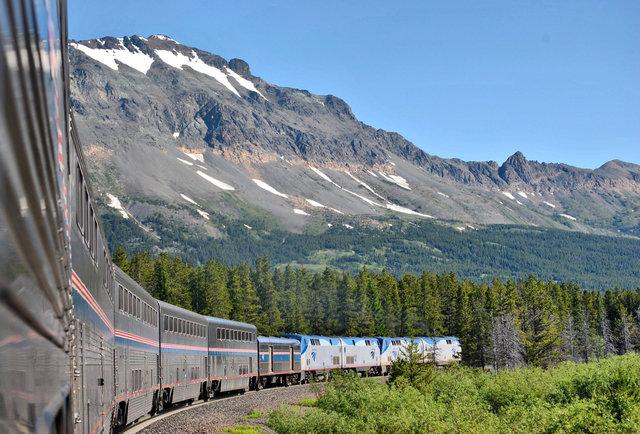
| Route 66 | Cities | Beaches |
|
Empire Builder |
 |
Sunset Limited |
Palmetto |
Crescent |
VIA |
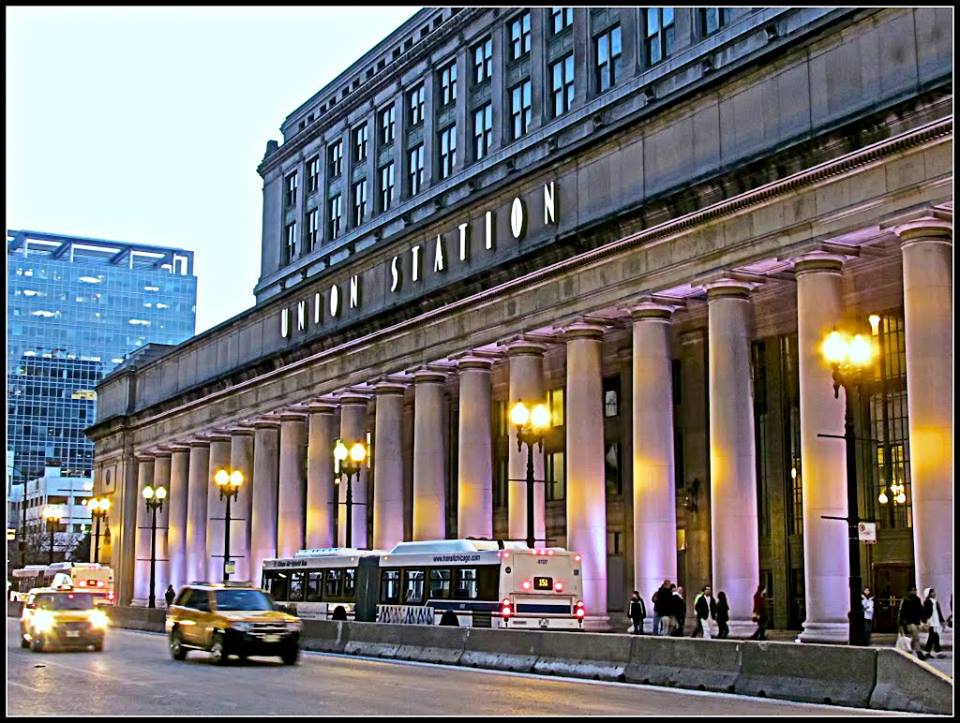 |
Amtrak runs a lot of great trains. At the top of the list would be the Chicago-San Francisco Zephyr, the Chicago-L.A. Chief, and the Chicago-San Antonio-L.A. Texas Eagle. But nothing --- nothing --- touches the Empire Builder. Created and run for 100 years by the Great Northern Pacific railroad of James Hill, the Empire Builder was taken over by Amtrak in 1974. It has kept the run just as it was. The Empire Builder runs from Chicago to Seattle. It takes three days and stops at Milwaukee, St. Paul, Fargo, Minot, Havre, Glacier National Park, Whitefish, Spokane, Leavenworth and Everett. The train has 13 cars from Chicago to Spokane, where 'several of the cars are split off, coupled to a different engine and sent to Portland. The rest continues on to Seattle. On the return trip, the train stops while the Portland segment is coupled to the back of the main train. You'll begin your trip in Chicago Union Station, a beautiful century old treasure that is really, with due respect to New York City and Los Angeles, the heart of the Amtrak system. The photo at left shows the front entrance and the one below the main waiting room. |
A century ago, cities considered train stations their front door. Before car and plane traffic rose after World War II, trains were how most travellers arrived. The appearance a station presented and the services it provided created the first impression everyone received. Both railroads and cities took great pride in their stations and went to great lengths to guarantee that their appearances and services were the very best anywhere. Chicago still thinks like this. You could spend a day wandering around Chicago's Union Station, admiring its architecture and taking photos. The main entrance announces that this is a place of significance, where important people pass through and are provided with the proper amenities. This is the hub of Amtrak operations. Trains depart here heading north, south, east and west. Every one of Amtrak's famous long distance trains begins here except for the ones running up and down the coastlines. It's more like an airport, with trains arriving and departing constantly. The El (the local mass transit), taxiis, buses, Ubers, and even watercrsft pick up and drop off here. Inside, Union Station is cavernous. Shown at right is one of the waiting rooms. Works of art, especially sculpture and paintings, decorate each room and hallway. Staircases are wide. There's lots of marble and brass. Murals depict scenes from Chicago history. The station is busy 24 hours a day. There are snack bars, stores, news stands, ticket counters and baggage areas. With your boarding pass you gain admission to an exclusive waiting area called the Metropolitan Lounge, offering living room style comfortable chairs and sofas, work tables, plugs, wide screen TV, wifi and free snack bar. Chicago Station originally opened in 1925. It cost $75 million and took 10 yars to build. |
 |
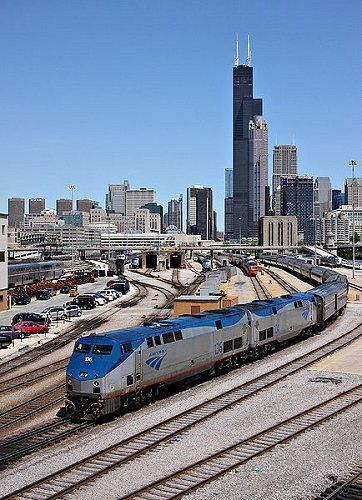 |
Including approaching and departing tracks, it covers nine city blocks. A total of 24 tracks enter the station area. Last year three million four hundred thousand passengers passed through the station, averaging 140,000 a day. Amtrak officially owns the station. 27 Hollywood movies have been filmed here. Several past restorations have kept the building modern and another series of renovations is about to begin, some involving trackage and some involving added customer services inside rhe station. If your layover between trains is long enough, you're only a few blocks from the Willis Tower, Michael's Grille (the official beginning of Route 66), and Greektown, the largest Greek community in the world outside Greece and home to several of the best Greek restaurants and the world's largest Greek museum outside Greece. Every 30 minutes or so a new train arrives, or the announcer calls for boarding a departing train, and a flood of riders fill the track area. It's a busy place, with a dozen tracks. Trains are arriving and departing, loading and unloading, and being cleaned and serviced in preparation for a departure in perhaps an hour or two. The Empire Builder is the best of what Amtrak has to offer. It uses new diesel engines but classic 1983 built cars. It has a dining car that if it were a brick and mortar restaurant would rank four stars. It has a beautiful observation car with heavily padded armchairs facing floor to ceiling windows so riders can enjoy the views. There's a snack bar for between meals. The train offers three sleeping accomodations : roomette, deluxe room with full bath, and a family room that can sleep four. For those on a bare bones budget, there are Coach cars, with reclining seats and much more room than an airplane. With the purchase of a sleeper compartment, three meals a day for each occupant come free. Those in Coach can buy theirs as they go. There's no wifi on board (Congress won't fund it), but there's a workaround. You can equip your IPhone with wifi, then plug the IPhone into the computer. |
| The photo above shows the train pulling out, with the Chicago skyline in the background. You get a different view of the city from the train than you get from a car or bus. And it takes a while to roll past the city and northern suburbs. Eventually, you reach Wisconsin and the scene becomes rural, as seen at right. You'll stop at Milwaukee at 4 pm. You'll probably be eating dinner as the train stops at the Dells, a tourist town built on both sides of the Wisconsin River. |  |
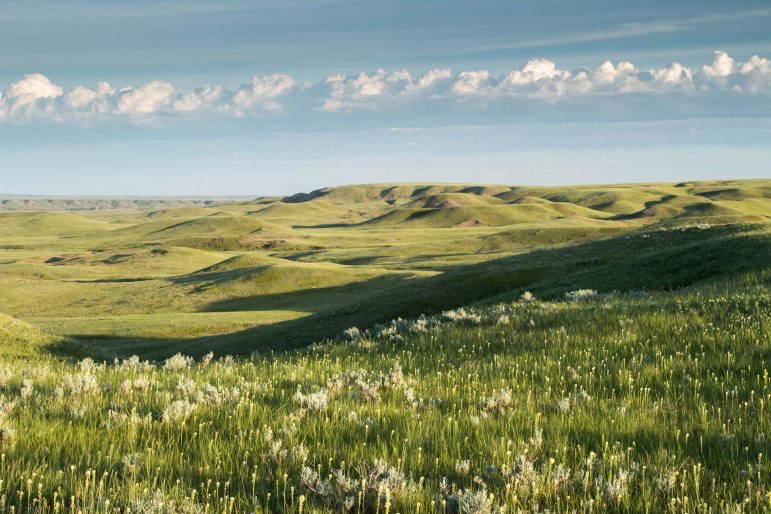 |
The Empire Builder stops in St. Paul for about 20 minutes at around 10:30 pm. You can step outside, check out the station, and look across the Mississippi River at Minneapolis. You'll be asleep through Fargo and Grand Forks. Even if you're in Coach or a Roomette, the train includes surprisingly nice showers. Amtrak provides towels, washcloths and soap. Be aware, though, that the train fills up, and Amtrak uses variable pricing, so the closer to train time you order the more you'll pay. For these two reasons, we urge you to make reservations early --- about three months early. Remember to pack light. An Osprey Farpoint or a small wheeled pack is best. They have to fit in the bedroom with you and there's very limited space. A small pack can hang from one of the hooks. Bigger packs must be stored in the baggage area by the car entrance. |
You wake up the morning of the second day around 8:30 in Minot, North Dakota. For the next several hours you'll be crossing the high, wide, rolling landscape Conrad Richter named the Sea of Grass. This is where the Sioux, Crow and Blackfeet roamed for 10,000 years, and White Men made famous as The Cattle Empire. Today they still raise cattle here and you'll see lots of them. But you'll also see miles and miles of Wheat, and a 21st Century arrival, the oil rig. You'll see hundreds of little "grass hopper" rigs and occasional much bigger rigs. The tallest are for fracking. You're passing through the northern edge of the Bakken Oil Field, which has made the U.S. energy independent and postponed the day when we have to face the full impact of the Energy Crisis. You'll see long trains of black oil cars sitting on sidings or rolling past. A good pair of binoculars is useful here. You'll see Antelope, Buffalo, Mule Deer, Grouse, Fox, Coyote, Prairie Dogs, and maybe an occasional Wild Horse, plus if you're really sharpeyed Burrowing Owls, Hawks and near water Golden Eagles. None of them seem particularly bothered by the passing train. They see two a day and long ago decided they were no threat. |
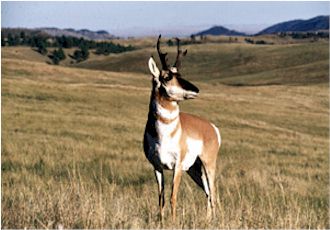 |
|
In the morning you'll see Tall Grass Prairie, but by afternoon you're in the rain shadow of the Rockies and water becomes scarce. You've entered the Short Grass Prairie. In the Spring and after prolonged rains the Prairie will erupt in a display of Wildflowers. Smaller mountain ranges pop up. If you're looking out the south facing windows, you'll see the Belt Mountains. If you're facing out the north facing windows, you'll see the Sweet Grass Hills (photo left). The highest of these peaks are between 6,000 - 7000 ft. If you come in the Spring, there will still be snow on the flanks of both ranges, but by June this snow has melted. These ranges were formed by volcanic action. Both these small mountain ranges contain excellent backpacking. They also contain more wildlife than surrounding areas. Blackfeet saw the Sweetgrass Hills as the gateway to the Other World. When the Great Spirit came to visit This World, this was where he emerged. Blackfeet youth were brought to the Sweet Grass Hills for their seven night Vision Quests. |
Here you'll officially enter the Blackfeet Reservation, one of the largest in north America and adjacent to Glacier National Park. The Blackfeet have always been one of the most hostile, protective and independent tribes. When the famous Lewis & Clark Expedition followed the Missouri up to Yellowstone, the Blackfeet met them with outstretched arms, welcoming them and offering hospitality. A French guide, Charbonnet, shot the leader of the Blackfoot welcoming party. The Blackfeet immediately decided White Men were unrtrustworthy and relations have been testy ever since. The Blackfeet were one of the few tribes who got to keep their actual homeland for a reservation, and it's one of the largest reservations, extending from the national park on the west to far out on the Montana Plains on the east They've become somewhat domestic, raising horses, cattle, wheat and vegetables and working for the National Park Service. Most live in White style homes. But a growing number have rejected these and live all or part of the time in an original Tipi, as seen in the photo at right. The "town" on the reservation is Unca-Powhat-Nin, meaning Where The Mountains Meet The Plains in Blackfeet. White men call it Browning, named after an early Indian Affairs Secretary. It has about a thousand population plus a high school and community college. The Plains Indians Museum and Plains Indians Art Gallery are both worth visits. |
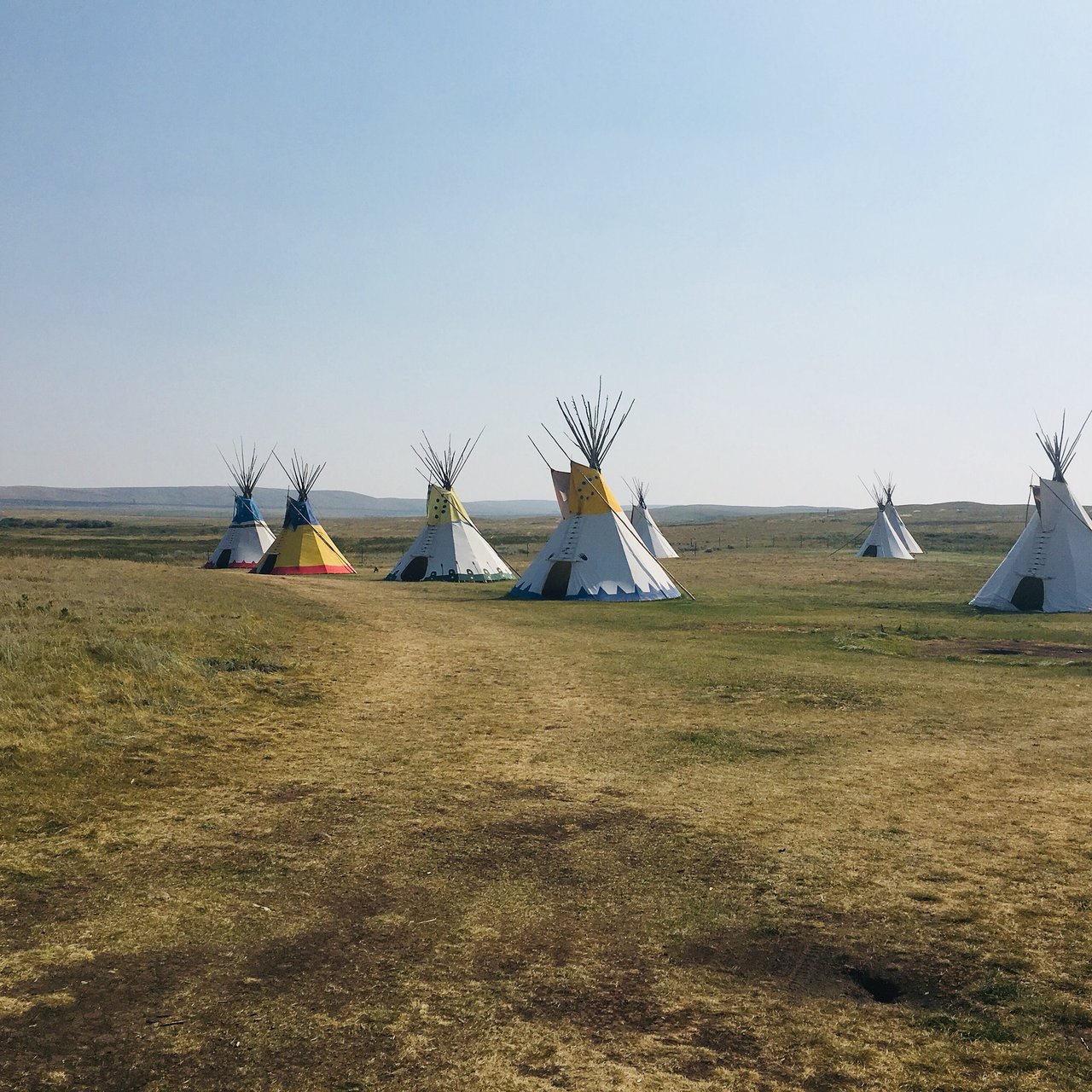 |
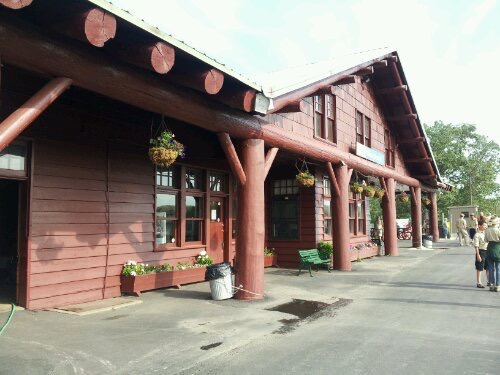 |
The next stop after the reservation is East Glacier, entrance to Glacier National Park. The station, shown at left, and lodge, are built of heavy logs in western national park style. The second floor of the station is an apartment for the Amtrak agent and his or her family. Amtrak usually reaches East Glacier about dinner time. Glacier owes its existence to the railroad. Great Northern Pacific founder James Hill helped found the park and was one of its enthusiastic advocates, believing it would attract as many passengers as his rival line, the Northern Pacific, got from Yellowstone Park and the Santa Fe got from the Grand Canyon. He advertised it heavily in Chicago and Seattle. Even today, Amtrak is a major way to come to Glacier, and in Summer a huge number of vacationers disembark from the trains at either East Glacier, Essex or West Glacier, all of which have lodges. The usual way to visit Glacier is to either come in on the train and stay at Glacier Park Lodge, up the long walkway behind this station; or to spend one night at the Lodge and then take the "Jammer Bus" on its full day circle of the park's seven other lodges and stay at one of them. But there is a full range of fishing, hiking, backpacking, horseback riding, white water rafting and other activities at the lodge right here. |
You'll be riding along the southern edge of the park for about 90 minutes. The train has to climb to Marias Pass, where you cross the Continental Divide. You'll notice a tremendous volume of freight as the containers of everything from food to electronics to clothing are unloaded from Seattle and shipped eastward. Just after crossing the Continental Divide at Marias Pass you'll come to Essex, which originated as a railroad community and is now a major tourist stop. A dorm was built here to house railroad crews. One crew would work the train from Seattle to here, spend a night, then work the other train going back to Seattle. A different crew would work the train coming West from Minot, spend the night here, then work the other train heading back to Minot. Freight crews worked in the same way. Engineers on both freight and passengers trains spent the nights here. A new crew change location has been established at Whitefish, so this is now the Isaak Walton Inn, a favorite among fishermen, hikers, white water rafters, kayakers, and photographers. It contains a restaurant and gift shop. Railfans consider Essex one of the top 10 train watching points in North America. Just out of this photo is a row of Cabeese which have been converted to tourist cabins. |
|
|
Essex is a "flag stop," meaning if a passenger plans to get off, they notify the conductor, and if a passenger needs to board, the inn manager hangs a flag to notify the engineer. Snow is an issue here 10 months a year. Trains pass through a dozen man made tunnels (photo, left) You"'ll also notice the snow fences mounted along the tracks beginning with the Blackfoot reservation. When you reach the snow tunnels look up, especially with a pair of binoculars. For along this area Mountain Goats scramble on the cliffs. In the Winter, travelling this route is a continual challenge. Amtrak has had trains blocked here by snow for as long as three days. Because of ice buildup, avalanches, and rockslides freight trains have been blocked and even derailed here, which in turn blocks Amtrak trains. As you head west from Glacier, Amtrak makes a 20 minute stop at Whitefish, a resort famous for skiing, fishing and mountain biking. The ski resort is little known back East but is the ski resort for Washington, Oregon, and Montana. The only way to get here in Winter is by Amtrak. While all the other major Rocky Mountain ski resorts are on east facing slopes, Whiteface faces West. This means it receives much more natural snow and needs to make far less artificially. It's great for powder skiing. |
The Amtrak station at Whitefish is worth a look while the train refuels. It contains a passenger train museum. The station itself is a well preserved gem from the mid 20th century, one of the nation's more beautiful small town depots. Walking through to the front you find yourself looking straight up Main Street. Whitefish would be a fine trip some other time, in any season. It would offer a mid Summer escape from heat and humidity. It's one of America's finest fishing centers. The backpacking here is world class. In Summer the ski resort is refitted as a mountain biking Paradise. |
|
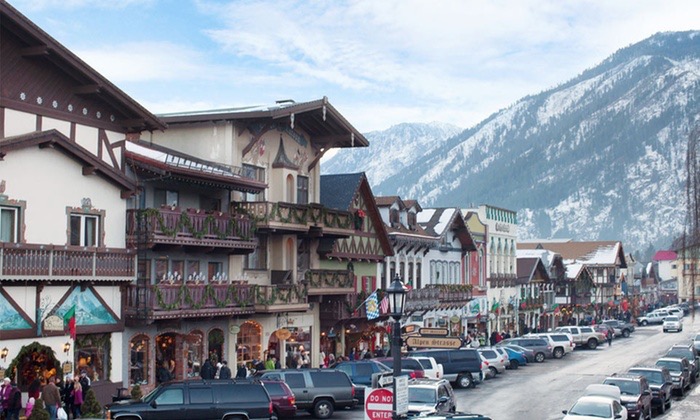 |
The sun usually sets as Amtrak departs Whitefish so you cross Montana's Cabinet Mountains, all of Idaho, and eastern Washington in darkness. At Spokane you may be jolted awake by the uncoupling of the rear cars, as they head for Oregon with a separate engine. Then you'll sleep through another several hours and wake up at sunrise as the train pulls into Leavenworth (photo, left). This would be yet another good place to come on a separate Amtrak trip and spend a week. Leavenworth is the largest Bavarian village in the world outside of Bavaria. It's high in the Cascade Mountains, so is a fine escape from Summer heat and humidity. It has several good restaurants and several more excellent motels. But most of all, Leavenworth is a hiking and backpacking mecca. The Enchantments, a chain of pristine high country lakes, stretches above the town, about an 8-10 mile hike in. Other trails fan out in all directions, ranging from 8-10 mile day hikes to 30-60 mile backpacking routes. |
You're in the Cascade Mountains here, some of the most rugged and isolated in North America. North Cascades National Park stretches out further north but the area around Leavenworth is national forest. Grizzly Bear, Grey Wolves and Mountain Goats roam this area and are not particularly afraid of hikers. The Wenatchee River flows through town and Ospreys and Eagles perch along its banks and fish in its waters. Even from the train, wildlife sighting is plentiful. The number of hikers and backpackers wanting to hike here is so great the Forest Service has gone to a lottery permit system. Permits to some of the lakes are easier to obtain, but the highest lakes are much in demand and hard to obtain, especially in July and August. No individual or group is allowed more than one permit per year. Snow does not melt off until June and closes trails again in late October. This is terrain for experienced hikers and backpackers with proper skills and equipment The terrain is steep, there is no cell phone reception, and rescue is difficult. Days can be quite warm but temperatures plunge at night. |
|
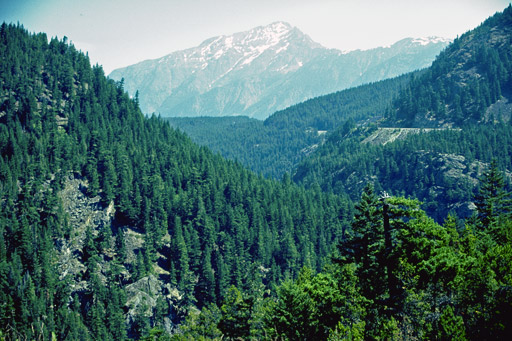 |
The trip from Leavenworth to Everett is spectacular, taking you through some of the deepest and most rugged forest in the U.S. You'll be eating breakfast in the dining car while cruising through these huge stands of conifers, deep canyons and jagged peaks. One attraction this morning is Cascade Tunnel, at eight miles the longest railroad tunnel in regular use in North America. Considering that this tunnel was built in the 1920s, it is amazing that it still sees such heavy use in the 21st Century by both freight and passenger trains. The tunnel is ventilated and has various safety features. As you finally descend to the coastline, you'll cruise right along water's edge for several miles coming into Seattle. |
Seattle's station is not one of the nation's largest but it is a century old classic. Built in 1906, it was recently restored and is bright, modern and spacious. It serves Amtrak, the local mass transit, Greyhound buses, and the increasing fleet of Uber vehicles. There are no indoor concessions but food trucks park just outside and serve everything from breakfast tacos to fish sandwiches. Downtown Seattle has grown up around the station so you're in the heart of everything : Pioneer Square, the Waterfront, Pike Market, etc. From the Seattle station you have numerous options. You can catch the Coastal Starlight south to Portlland, San Francisco and Los Angeles or the Cascade north to Vancouver. You can check into a hotel. There are several fine hotels within several blocks of the station. You can walk or catch an Uber to the docks and catch the next ferry out to Olympia National Park and one of the fine lodges there. You can rent a car and drive out to the Paradise Inn in Mt. Rainier National Park. No matter what season it is and what the weather is doing back East, prepare for rain and cool weather in Seattle. Always have a rain parka and jacket or sweater handy. Even if you get lucky and step off the train into sunny weather, there will probably be a cool breeze blowing in off the water. Remember that the Empire Builder gets into Seattle in the morning. You will probably not be able to check into your hotel room right away. You will likely have to check your bags and go exploring for several hours. Brace yourself for higher prices at restaurants, food trucks and fast food counters. Seattle is expensive. Budget for it, come prepared and enjoy the great seafood.
|
 |
|
|||
|